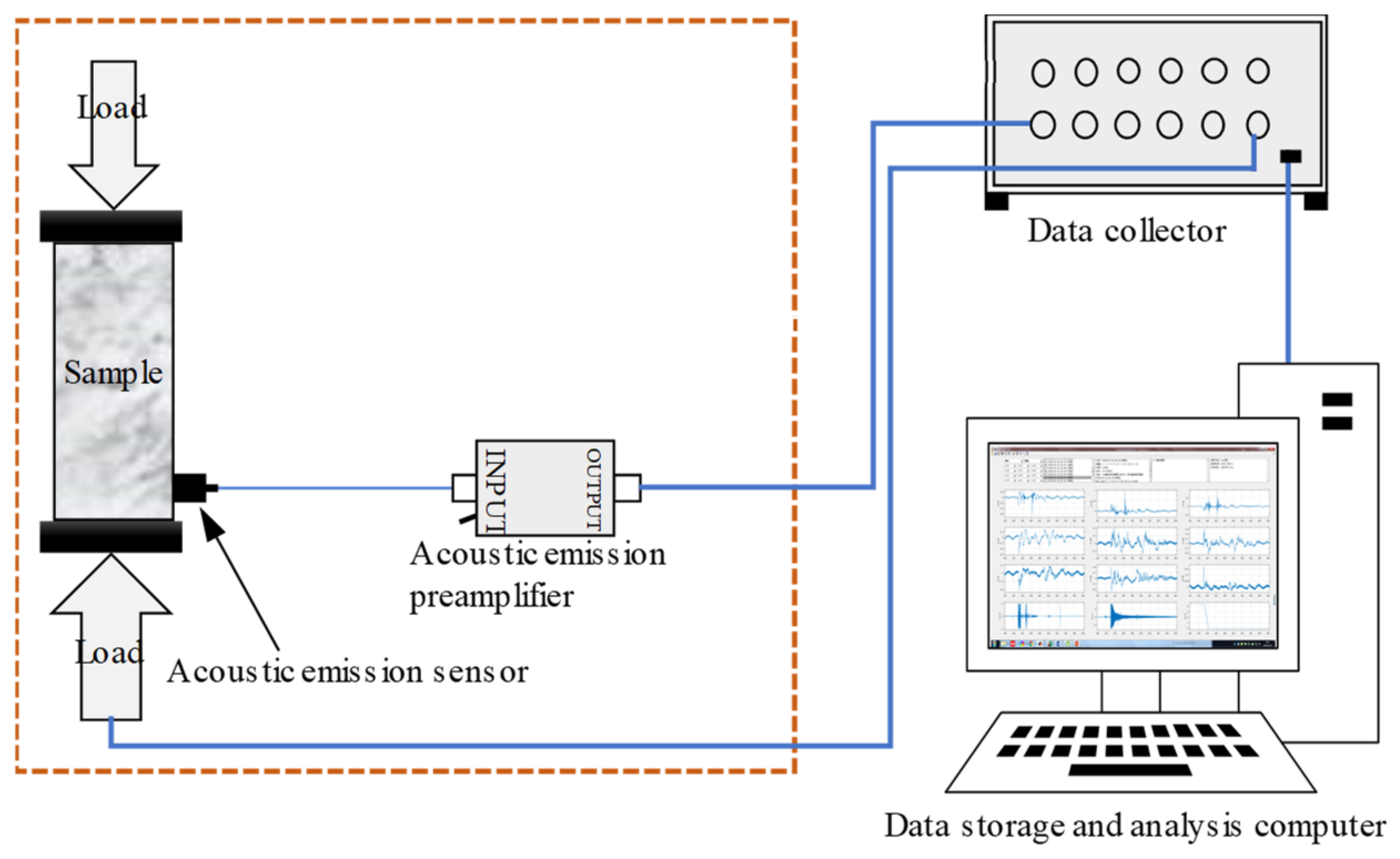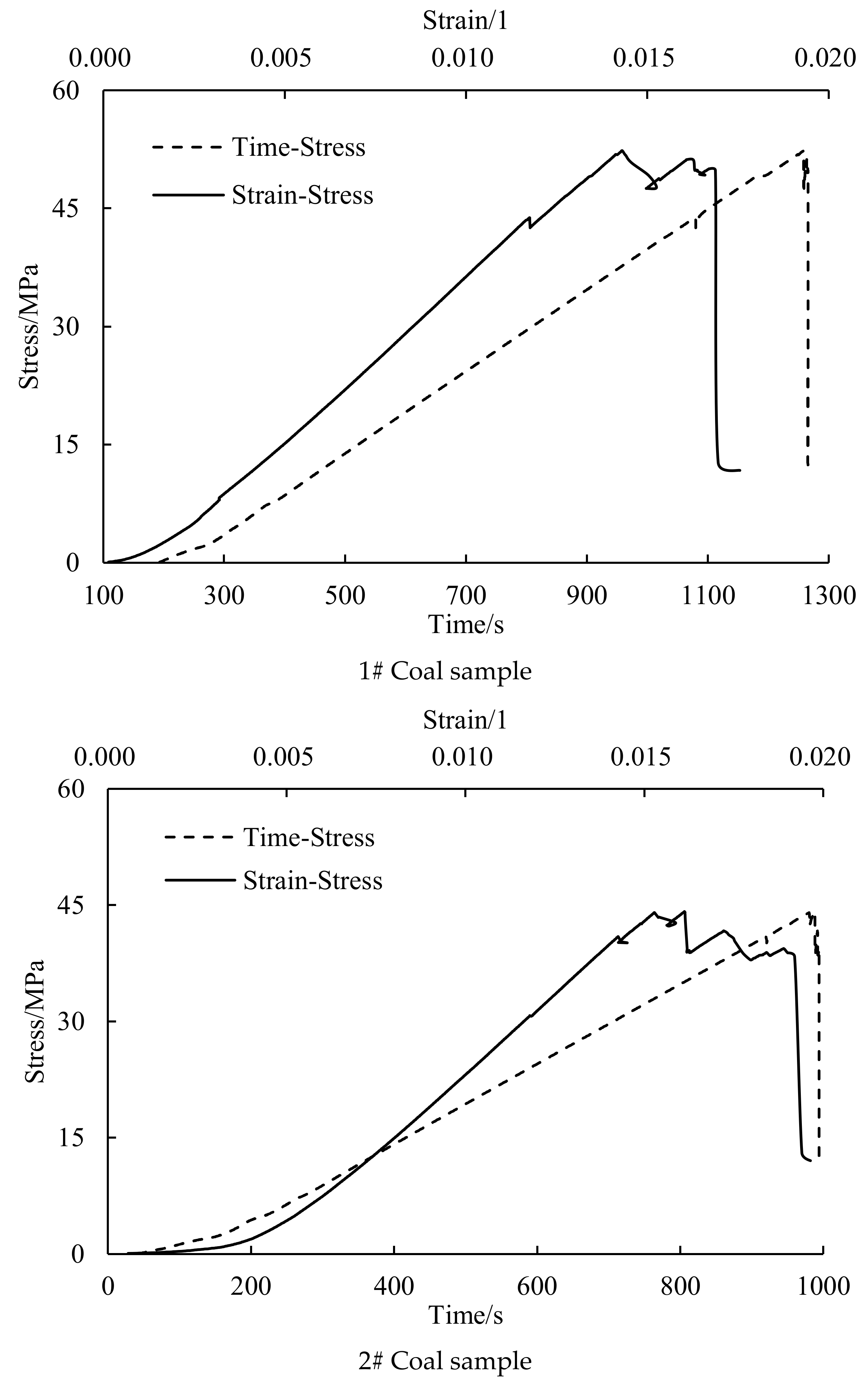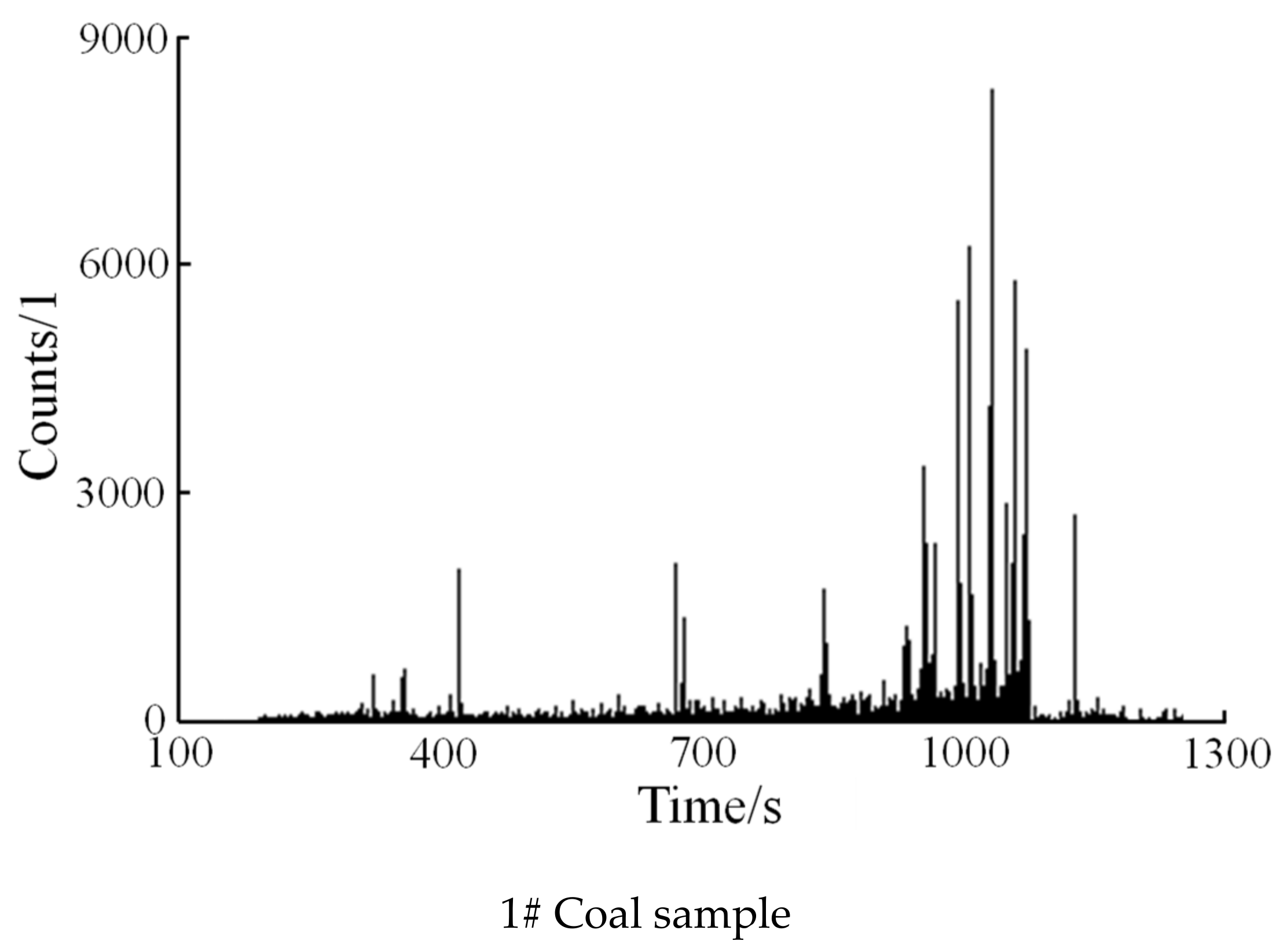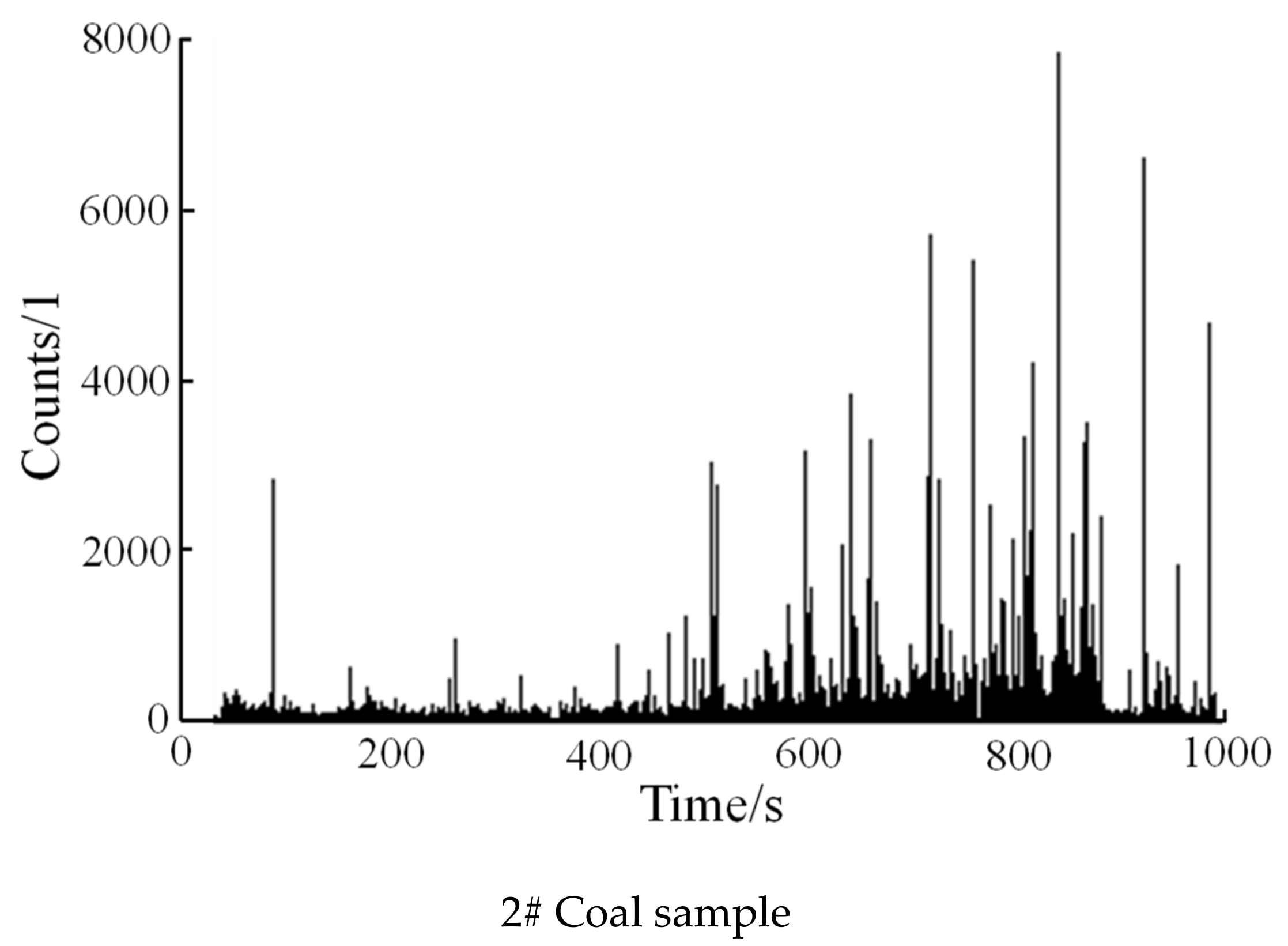Research on Prediction of Coal Sample Deformation Based on Acoustic-Emission Sensitive Index
Abstract
:1. Introduction
2. Material and Methods
2.1. Testing Device
2.2. Coal Samples
2.3. Experimental Principle and Procedure
3. Results and Discussion
3.1. Stress–Strain Test Results
3.2. Sensitive Indicators
3.3. Analysis of Acoustic Emission Counting Results
3.4. Discussion
4. Conclusions
- (1)
- AE tests were carried out during the uniaxial loading of coal samples, and the relationship between the deformation of coal samples and the AE response was established. It is believed that the AE counting parameters have good consistency with the deformation of coal samples, and the phase characteristics are obvious, so this index can be selected as a sensitive index for AE prediction of coal deformation in the study area.
- (2)
- The characteristics of AE in the loading process of coal samples were analyzed, and it was concluded that the AE count changes in the loading process show phase characteristics. It can be divided into three stages: the initial stage with a certain amount of infrasound events, the middle stage with fewer AE events, and the final stage with a rapid increase in AE events. The results of this stage correspond to the deformation of coal samples, and the characteristics of each stage are obvious, which can be used to predict the deformation of coal samples.
- (3)
- The different AE response characteristics characterize the differences in the internal structural characteristics of coal samples, which further strengthens the study of the differences in AE characteristics of different coal samples during the loading process and provides a new direction for studying the internal structural characteristics of coal samples.
Author Contributions
Funding
Conflicts of Interest
References
- Singh, M.; Tangirala, S.K.; Chaudhuri, A. Potential of CO, based geothermal energy extraction from hotsedimentary and dry rock reservoirs, and enabling carbon geo-sequestration. Geomech. Geophys. Geo-Energy Geo-Resour. 2020, 6, 16. [Google Scholar] [CrossRef]
- Zhou, X.M.; Wang, S.; Li, X.L. Research on theory and technology of floor heave control in semicoal rock roadway: Taking longhu coal mine in Qitaihe mining area as an Example. Lithosphere 2022, 2022, 3810988. [Google Scholar] [CrossRef]
- Raziperchikolaee, S.; Alvarado, V.; Yin, S. Quantitative acoustic emissions source mechanisms analysis of soft and competent rocks through micromechanics seismicity coupled modeling. Int. J. Geomech. 2020, 21, 04020269. [Google Scholar] [CrossRef]
- Li, X.L.; Chen, S.J.; Wang, S. Study on in situ stress distribution law of the deep mine taking Linyi Mining area as an example. Adv. Mater. Sci. Eng. 2021, 9, 5594181. [Google Scholar] [CrossRef]
- Lou, Q.; Song, D.; He, X.; Li, Z.; Qiu, L.; Wei, M.; He, S. Correlations between acoustic and electromagnetic emissions and stress drop induced by burst-prone coal and rock fracture. Saf. Sci. 2019, 115, 310–319. [Google Scholar] [CrossRef]
- Wei, M.; Song, D.; He, X.; Li, Z.; Qiu, L.; Lou, Q. Effect of rock properties on electromagnetic radiation characteristics generated by rock fracture during uniaxial compression. Rock Mech. Rock Eng. 2020, 53, 5223–5238. [Google Scholar] [CrossRef]
- Song, D.; Liu, X.; He, X.; Nie, B.; Wang, W. Investigation on the surface electrical characteristics of coal and influencing factors. Fuel 2021, 287, 119551. [Google Scholar] [CrossRef]
- Das, S.; Mallik, J.; Bandyopadhyay, K.; Das, A. Evaluation of maximum horizontal near-surface stress (SHmax) azimuth and its distribution along Narmada-Son Lineament, India by geogenic Electromagnetic Radiation (EMR) technique. J. Geodyn. 2020, 133, 101672. [Google Scholar] [CrossRef]
- Khan, N.M.; Ma, L.; Cao, K.; Spearing, A.J.S.; Liu, W.; Jie, Y.; Yousaf, M. Early Violent Failure Precursor Prediction Based on Infrared Radiation Characteristics for Coal Specimens Under Different Loading Rates. Rock Mech. Rock Eng. 2022, 55, 6939–6961. [Google Scholar] [CrossRef]
- Ma, L.; Zhang, Y.; Cao, K.; Wang, Z. An Experimental Study on Infrared Radiation Characteristics of Sandstone Samples Under Uniaxial Loading. Rock Mech. Rock Eng. 2019, 52, 3493–3500. [Google Scholar] [CrossRef]
- Cao, K.; Ma, L.; Zhang, D.; Lai, X.; Zhang, Z.; Khan, N.M. An experimental study of infrared radiation characteristics of sandstone indilatancy process. Int. J. Rock Mech. Min. Sci. 2020, 136, 104503. [Google Scholar] [CrossRef]
- Jiang, F.; Xun, L. Application of microseismic monitoring technology of strata fracturing in underground coal mine. Chin. J. Geotech. Eng. 2002, 24, 147–149. [Google Scholar]
- Liu, X.; Liu, Q.; Du, K.; Li, X.; Xie, Q. Acoustic emission features and P-wave first-motion polarity of tensile fractures in the rock. Chin. J. Eng. 2022, 44, 1315–1323. [Google Scholar]
- He, X.; Nie, B.; Wang, E.; Dou, L.M.; Liu, M.J.; Liu, Z.T. Electromagnetic emission forecasting technology of coal or rock dynamic disasters in mine. J. China Coal Soc. 2007, 32, 56–59. [Google Scholar]
- Nejati, H.R.; Nazerigivi, A.; Sayadi, A.R. Physical and mechanical phenomena associated with rock failure in Brazilian Disc Specimens. Int. J. Geol. Environ. Eng. 2018, 12, 35–42. [Google Scholar]
- AlShorman, O.; Alkahatni, F.; Masadeh, M.; Irfan, M.; Glowacz, A.; Althobiani, F.; Kozik, J.; Glowacz, W. Sounds and acoustic emission-based early fault diagnosis of induction motor: A review study. Adv. Mech. Eng. 2021, 13, 1–19. [Google Scholar] [CrossRef]
- Zhang, G.; Deng, Z.; Jiang, J.; Li, S.; Mo, Y.; Wang, J.; Ma, B. Acoustic emission characteristics of coal with strong impact proneness under different loading modes. J. Min. Saf. Eng. 2020, 37, 977–982. [Google Scholar]
- Zhao, Y.; Ran, H.; Feng, G.; Guo, Y.; Fan, Y. Damage evolution and failure characteristics of cemented gangue backfill body with different height-width ratios under uniaxial compression. J. Min. Saf. Eng. 2022, 39, 674–682. [Google Scholar]
- Zhou, Z.W.; Liu, J.F.; Zou, H.; Zhuo, Y.; Xu, Y.M.D. Acoustic Emission Characteristics and Damage Evolution of Rock Salt under Uniaxial Compression. J. Yangtze River Sci. Res. Inst. 2016, 33, 63–68. [Google Scholar]
- Li, W.; Huang, Y.L.; Gao, H.D.; Li, J.M.; Ruan, Z.Y.; Song, T.Q. Study on acoustic emission characteristics of gangue of different graduations during confined compression. J. Min. Saf. Eng. 2020, 37, 155–161, 168. [Google Scholar]
- Vorobieva, I.; Shebalin, P.; Narteau, C. Break of slope in earthquak esize distribution and creep rate along the San Andreas Fault system. Geophys. Res. Lett. 2016, 43, 6869–6879. [Google Scholar] [CrossRef]
- Qiu, Z.Y.; Pan, Y.S.; Luo, H. Study on influence of effective confining pressure on acoustic emission signal in coal fracture. J. Saf. Sci. Technol. 2015, 11, 47–53. [Google Scholar]
- Gong, F.Q.; Luo, S.; Li, X.B. Rules of linear energy storage and energy dissipation in red sandstone during tensioning. Chin. J. Rock Mech. Eng. 2018, 37, 352–360. [Google Scholar]
- Zhao, H.; Yin, G.; Li, H.; Wang, Z. Analysis on AE characteristic and its confining pressure effect of outburst coal containing gas. J. Chongqing Univ. 2013, 36, 101–107. [Google Scholar]
- Wang, B.; Ning, Y.; Feng, T.; Guo, Z. Experimental study on anchoring effect of brittle rock mass influenced by loading rates at low strain rate. J. China Coal Soc. 2019, 44, 2691–2699. [Google Scholar]
- Gao, Y.; Guo, P.; Li, X.; Li, Y.; Xu, D.; Zou, Z.; Qin, J.; Shi, G.; Li, S. Investigation of triaxial compression failure and acoustic emission characteristics of different reservoir rocks. J. Eng. Geol. 2022, 30, 1169–1178. [Google Scholar]
- Liu, H.Y.; Zhang, B.Y.; Li, X.L. Research on roof damage mechanism and control technology of gob-side entry retaining under close distance gob. Eng. Fail. Anal. 2022, 138, 106331. [Google Scholar] [CrossRef]
- Ma, Y.K.; Wang, E.Y.; Li, Z.H.; Liu, J.; Du, Z.S. Methane sorption and seepage in coal and characteristics of acoustic emission. J. China Coal Soc. 2012, 37, 641–646. [Google Scholar]
- Xia, B.; Li, Y.; Hu, H.; Luo, Y.; Peng, J. Effect of Crack Angle on Mechanical Behaviors and Damage Evolution Characteristics of Sandstone Under Uniaxial Compression. Rock Mech. Rock Eng. 2022, 55, 6567–6582. [Google Scholar] [CrossRef]
- Justo, J.; Castro, J.; Cicero, S. Notch effect and fracture load predictions of rock beams at different temperatures using the theory of critical distances. Int. J. Rock Mech. Min. Sci. 2020, 125, 104161. [Google Scholar] [CrossRef]
- Liu, S.M.; Li, X.L.; Wang, D.K.; Zhang, D. Investigations on the mechanism of the microstructural evolution of different coal ranks under liquid nitrogen cold soaking. Energy Sources Part A Recovery Util. Environ. Eff. 2020, 1–17. [Google Scholar] [CrossRef]
- Bayane, I.; Bruhwiler, E. Structural condition assessment of reinforced-concrete bridges based on acoustic emission and strain measurements. J. Civ. Struct. Health Monit. 2020, 10, 1037–1055. [Google Scholar] [CrossRef]
- Chen, N.; Li, P.; Han, H.; Zeng, Z.; Qiu, L. Acoustic emission characteristics of soft rock with schistose structure during deformation failure. Eng. J. Wuhan Univ. 2022, 55, 539–544. [Google Scholar]






| No. | Parameters | Test Range (Value) | Sensitivity |
|---|---|---|---|
| 1 | Stress | 0 kN~500 kN | 2.5 N |
| 2 | Strain | 0~150 mm | 0.002 mm |
| 3 | Monitoring frequency | 1 kHz~3 MHz | |
| 4 | Amplitude | 17 dB~100 dB | |
| 5 | Sampling frequency | 40 MHz | |
| 6 | AE input impedance | 50 Ω | |
| 7 | Impact defined time | 0~104 ms | 1.6 μs |
| 8 | Impact lockout time | 0~65 ms | 1 μs |
| No. | Diameter/mm | Height/mm | Peak Intensity/Mpa |
|---|---|---|---|
| 1# | 49.34 | 99.66 | 52.35 |
| 2# | 49.44 | 99.25 | 44.16 |
| 3# | 49.42 | 99.32 | 42.31 |
| 4# | 49.04 | 98.12 | 48.25 |
| 5# | 49.34 | 98.62 | 54.12 |
| 6# | 49.40 | 99.26 | 39.34 |
| 7# | 49.30 | 97.59 | 40.64 |
Publisher’s Note: MDPI stays neutral with regard to jurisdictional claims in published maps and institutional affiliations. |
© 2022 by the authors. Licensee MDPI, Basel, Switzerland. This article is an open access article distributed under the terms and conditions of the Creative Commons Attribution (CC BY) license (https://creativecommons.org/licenses/by/4.0/).
Share and Cite
Wang, M.; Zhang, J.; Jia, B.; Du, W.; Chen, Z.; Liu, S. Research on Prediction of Coal Sample Deformation Based on Acoustic-Emission Sensitive Index. Sustainability 2022, 14, 14875. https://doi.org/10.3390/su142214875
Wang M, Zhang J, Jia B, Du W, Chen Z, Liu S. Research on Prediction of Coal Sample Deformation Based on Acoustic-Emission Sensitive Index. Sustainability. 2022; 14(22):14875. https://doi.org/10.3390/su142214875
Chicago/Turabian StyleWang, Man, Jianguo Zhang, Bing Jia, Weihang Du, Zhaofan Chen, and Shuaitao Liu. 2022. "Research on Prediction of Coal Sample Deformation Based on Acoustic-Emission Sensitive Index" Sustainability 14, no. 22: 14875. https://doi.org/10.3390/su142214875




